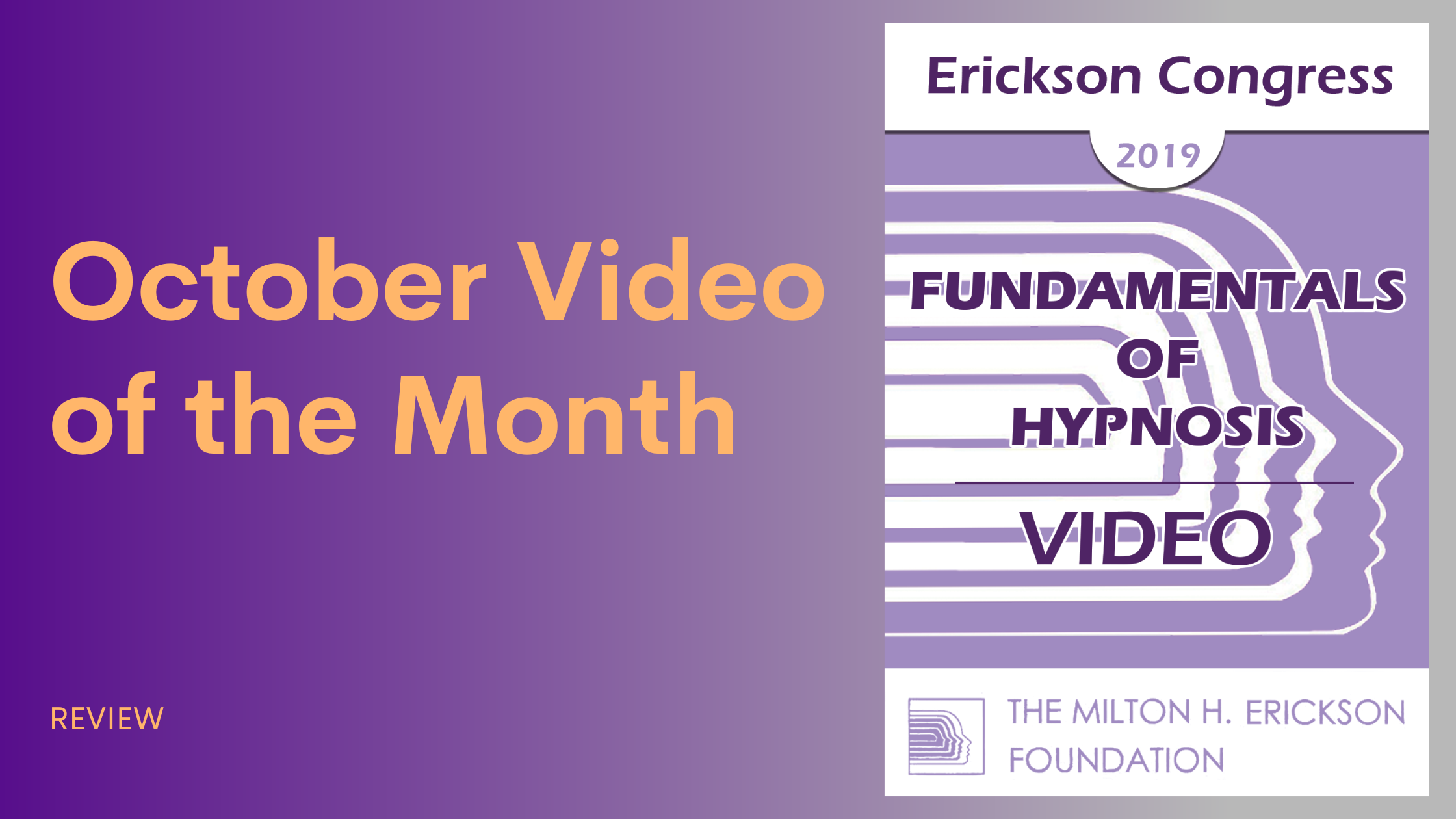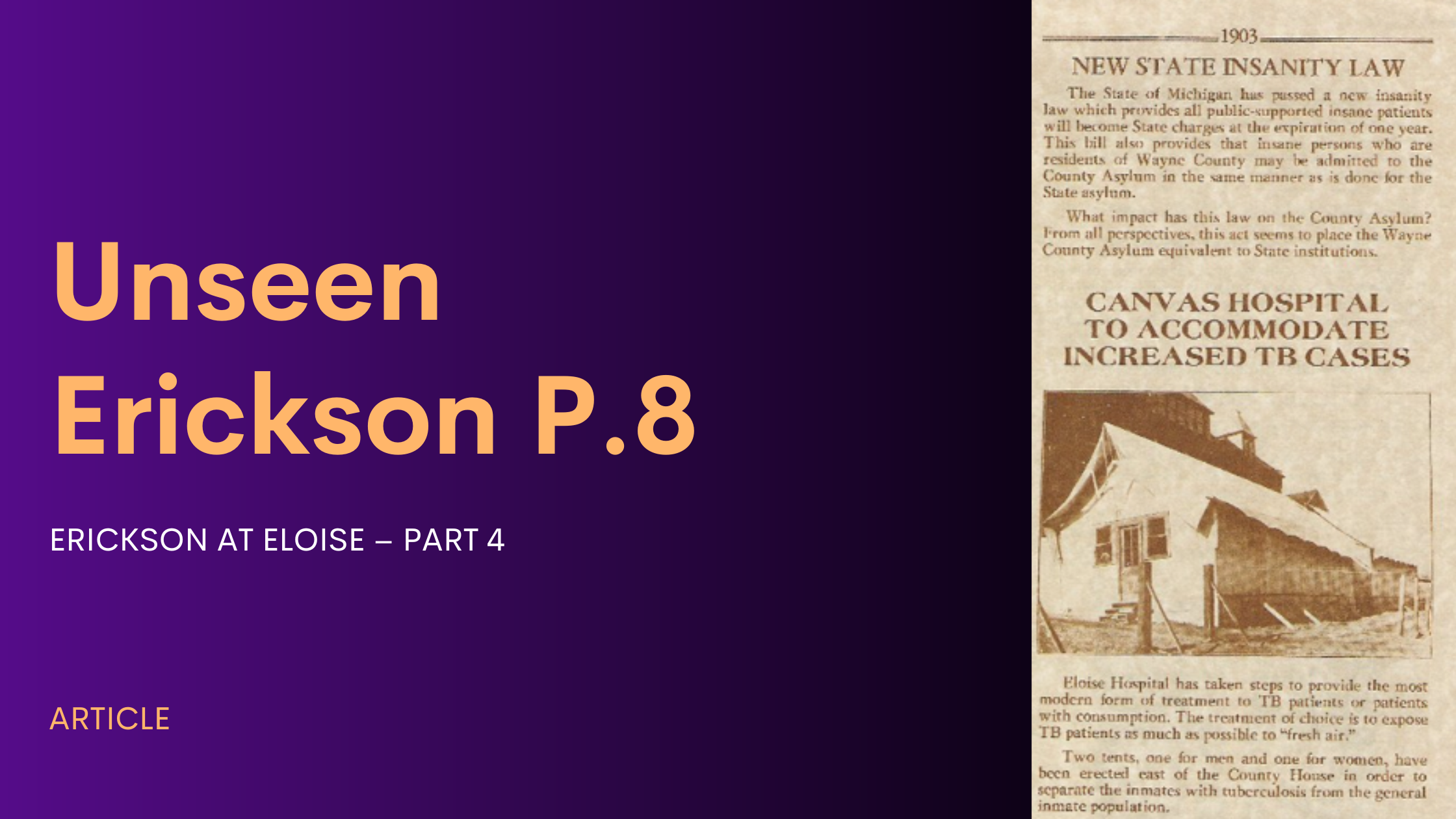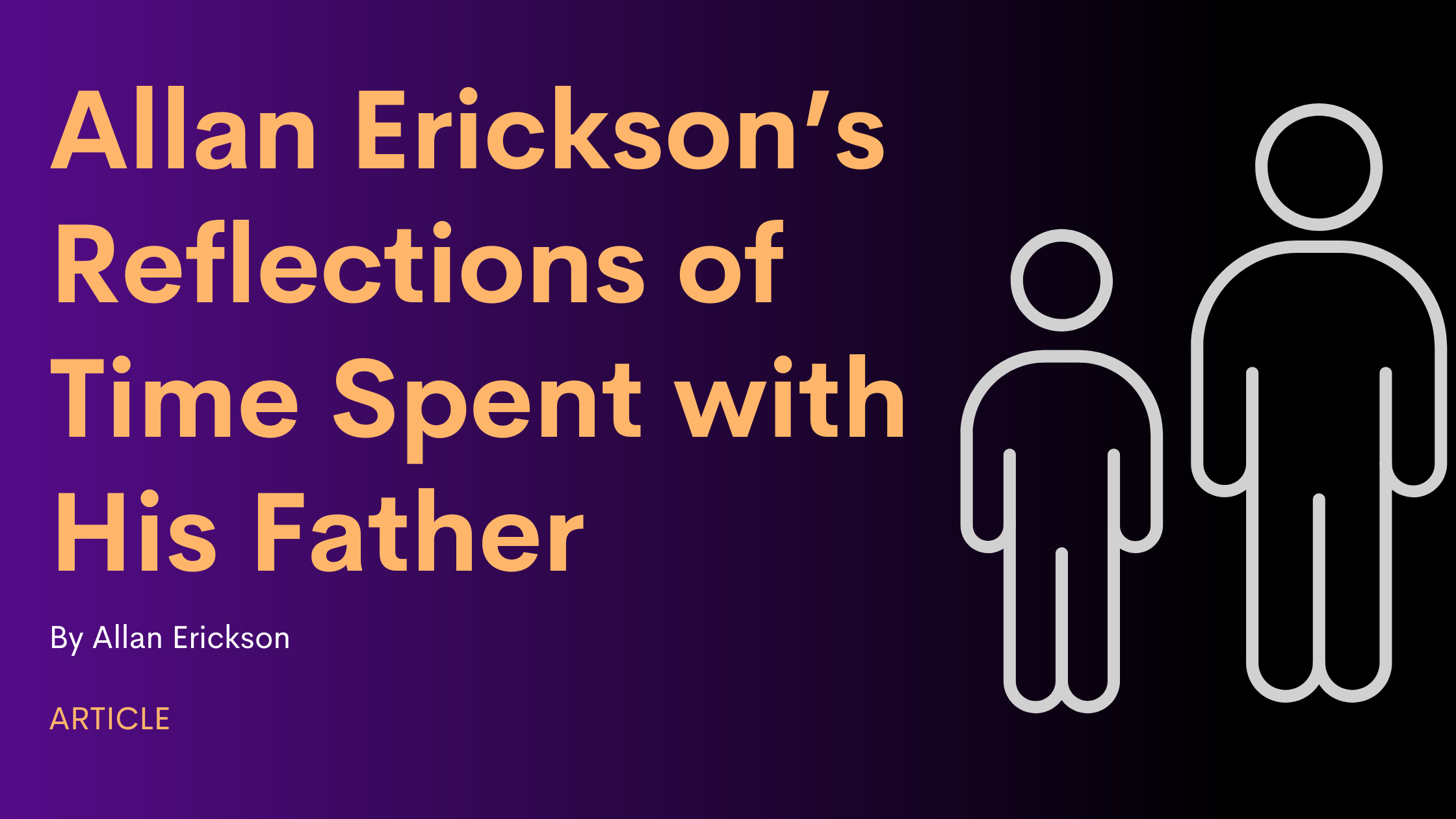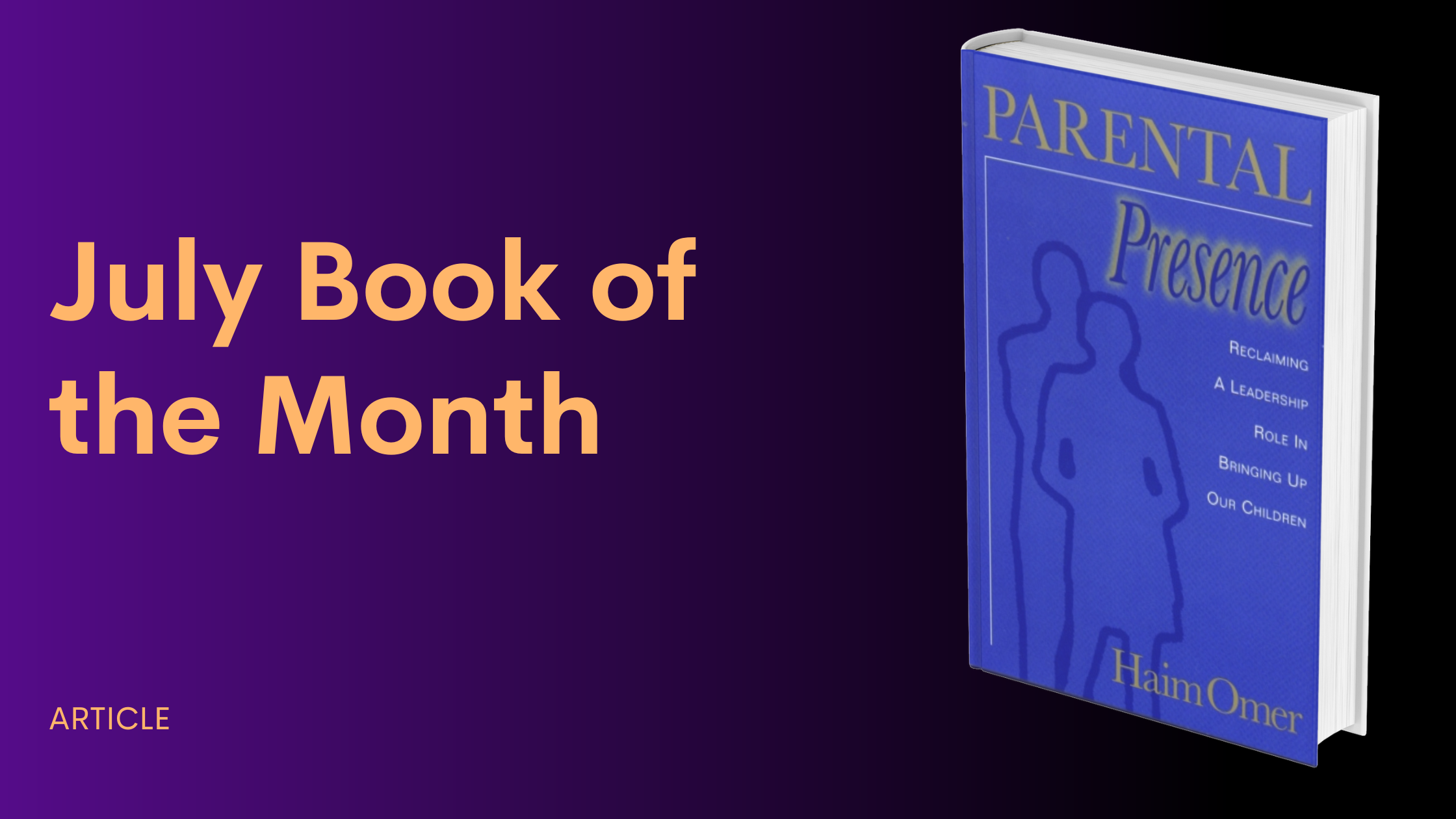
Where storytelling and creative learning come together
Calgary Conference Transcript with Mrs. Erickson
The following is an excerpt from a transcript of a conference held June 17th and 18th 1962 in Calgary, Alberta, Canada. It was sponsored by the Calgary Medical and Dental Hypnosis Society. John B. Corley, MD, appears to have arranged the event. Afterwards, he and his wife drove Dr. and Mrs. Erickson from Calgary to their next lecture stop in Glacier Park, Montana, and along the way they stopped at the Corley’s cabin in Banff. The doctors attending the seminar had requested that Erickson devote at least half a day to induction techniques. Additionally, they requested that he provide instruction on the handling of specific medical psychosomatic issues. Some were also interested in learning regressive techniques used to identify specific problems.
December Video of the Month
Unwrapping Family Roles: Whitaker’s Approach to Multigenerational Connection
The holiday season invites a special kind of gathering. Kitchens fill, living rooms spill over, and generations converge…sometimes joyfully, sometimes tensely. This time of year has a way of placing families face-to-face with ancestral dynamics: the traditions we inherit, the wounds we carry, and the roles we step into almost automatically.
James Braid - The True Father of Hypnosis
When asked about James Braid, Ernest Rossi said, “Braid is the true father of hypnosis (personal communication, Dec. 7, 2001). His work forms the basis of what I’m doing today.” This praise becomes understandable after a quick look at Braid’s contributions. He not only popularized the terms hypnosis and hypnotist; he first explained trance states as the interplay of physiology and psychology.
November Video of the Month
This ongoing series highlights keynotes, workshops, and demonstrations from past Erickson Foundation conferences…showcasing the most influential voices in psychotherapy. These archival recordings offer more than historical interest; they hold lasting clinical value. Each session distills complex therapeutic ideas into lived examples, practical applications, and subtle demonstrations of the art of therapy. This month's selection features Cloé Madanes working live with a couple struggling over Thanksgiving plans.
November Book of the Month
Learning to See What Was Always There Jan Crawford’s The Disorderly Soul: Aligning with the Movement of Love traces a personal and professional evolution that starts in traditional psychoanalysis and then moves into a profound engagement with systemic healing. Expanding the Professional Frame Crawford’s early training gave her a foundation in individual psychology. However, over time she began to sense that some of the difficulties she and her clients faced were connected to a wider field of family and ancestral experiences as well. That recognition led her to Bert Hellinger’s Family Constellation work.
Erickson Paper on Pain Control
Milton Erickson’s paper, “An Introduction to the Study and Application of Hypnosis for Pain Control,” was first published in French in 1965 in Cahiers D’Anesthesiologie. It was later published in English in April 1967 in College of General Practice of Canada Journal.
Diagnosis From Design
In 1986, Dr. Jeffrey K. Zeig received a handwritten Christmas letter from Elizabeth Erickson, along with one of her husband’s most treasured books — Hans Prinzhorn’s Bildnerei der Geisteskranken (1922), or Artistry of the Mentally Ill. Prinzhorn’s book was among the first to treat the artwork of psychiatric patients as creative expressions worthy of aesthetic and psychological respect. His research challenged the boundaries between madness and genius…
October Book of the Month
William Glasser: Champion of Choice by Jim Roy (Zeig, Tucker & Theisen, 2014) Jim Roy’s Champion of Choice brings William Glasser’s path vividly to life, tracing how one psychiatrist’s lifelong tendency to question authority reshaped therapy and education. From his Depression-era Cleveland beginnings to his challenge of psychiatry’s medical model, Glasser kept revising his own assumptions in light of experience. During his career he built an international network of institutes, workshops, and conferences that carried his ideas into schools, clinics, and counseling rooms around the world.
October Video of the Month
This ongoing series highlights keynotes, workshops, and dialogues from past Erickson Foundation conferences—showcasing the most influential voices in psychotherapy. These archival recordings offer more than historical interest; they hold lasting clinical value. Each session distills complex therapeutic ideas into lived examples, practical applications, and subtle demonstrations of the art of therapy. This month’s selection is Stephen Gilligan, Ph.D. “The Primacy of Non-Verbal Communication in Creative Trance Work”
Unseen Erickson P.8
According to “An Epic Life 2” by Jeffrey Zeig, Ph. D., Erickson served as director of psychiatric research and training at Eloise from 1934 to 1948. From 1938 to 1942, he also served as instructor, assistant and associate professor in the psychiatry department of Wayne University College of Medicine in Detroit, Michigan. From 1942 to1948, he was a full professor at the Graduate School. While at Eloise, Erickson wrote clinical papers explaining some of his theory and experiences with hypnosis. He also conducted research. This blog post discusses the organization of the research department, the research conducted, his annual reports from 1936 to 1939, job descriptions for himself and for staff, and summaries of the number of clinicians working for him year-to-year.
September Book of the Month
Bert Hellinger’s name is synonymous with family constellations, the therapeutic method he pioneered to reveal hidden patterns in family systems. But in On Life & Other Paradoxes: Aphorisms and Little Stories (2002), Hellinger does something different: he distills his decades of experience into sayings, parables, and reflections. The text moves between meditation and paradox, with each page inviting the reader to see healing from a different perspective.
September Video of the Month
This is a series exploring keynotes, workshops, and dialogues from past Erickson Foundation conferences—featuring the field’s most influential voices. These recordings from The Milton H. Erickson Foundation archives offer historical interest and hold lasting clinical value. Each session distills complex therapeutic ideas through lived examples, practical experience, and the subtle choices of the presenters and participants. These sessions continue to invite reflection, offer perspective, and reconnect us with core principles that remain relevant across time and context. This month’s selection is Feeling Great: High-Speed Cognitive Therapy – David Burns, MD
Allan Erickson’s Reflections of Time Spent with His Father
Almost exactly 50 years ago, shortly after I moved out and was living at college, I successfully played a practical joke on my dad. However, in a way the joke is on me because I learned a great deal about my father during the course of this practical joke. I had a kind of contest with my older sister, Betty Alice. We would carefully go through whatever was …
Resource Guide
Milton Erickson is known as one of the pioneering psychotherapists of the 21st century. The Milton H. Erickson Foundation has content surrounding this genius man that is free and available for purchase. From countless books, exciting streaming content, online reading material, and more, we have everything you need to learn about Milton Erickson. Whether you are just learning about him for the first time and don’t know where to start or are an experienced Ericksonian eager to get your hands
August Video of the Month
Reid Wilson, PhD, has spent over four decades refining and advancing treatment protocols for anxiety disorders and obsessive-compulsive disorder (OCD). Author of multiple influential self-help books, including Stopping the Noise in Your Head and the classic Don’t Panic, Wilson is widely regarded for translating evidence-based approaches, particularly exposure and response prevention (ERP), into practical, accessible strategies for both clinicians and clients. His collaborations with leaders
August Book of the Month
In “Reflections on Relationships with Self and Others” (2009), Jerry M. Lewis, M.D., a seasoned psychiatrist and psychotherapist, invites readers into his lifetime of clinical wisdom. Lewis, who passed away in 2021, left behind more than six decades of contributions to the field. He was known for his work at the Timberlawn Psychiatric Research Foundation in Dallas, where he studied families, marriages, and the ways people grow or stagnate. Both a careful researcher and a compassionate clinician, he had a gift for blending scientific understanding with lived human experience.
Erickson Biography Excerpt
The following is an excerpt from the biography on Milton Erickson and was taken from an interview with Paul Lounsbury and Nancy Winston in May 1993. Paul C. Lounsbury and Nancy Winston were married from 1987 to 2003. They live in New York. Lounsbury is a marriage and family therapist and Winston is a clinical social worker and therapist. In the 1970s, Paul Lounsbury and Nancy Winston met at a transactional analysis conference and they began studying together. Both had read Uncommon Therapy (Haley, 1973) and both were intrigued with Milton Erickson. Lounsbury visited Erickson first, then the two went together. For the next few years, they visited separately or together. Lounsbury recalled his first visit:
July Video of the Month
This month’s selection is Lynn Lyons, LICSW – "Humor, Hypnosis and Homework: Concrete Strategies for Helping Anxious and Depressed Kids in and out of the Therapy Office" Brief Therapy Conference 2016 | San Diego, CA This month’s spotlight features Lynn Lyons, LICSW, whose direct, funny, and refreshingly honest approach to treating childhood anxiety makes this lively 2016 workshop a standout. If you work with anxious or depressed kids (or their anxious parents), you’ll walk away from this video with concrete tools you can utilize immediately.
July Book of the Month
When ‘Parental Presence’ is the Intervention If you ever work with parents that are exhausted, heartbroken, and overwhelmed, wondering how their once-sweet child became unreachable, then Parental Presence is a book worth having on your shelf. Rather than swinging between being too soft or too strict, Haim Omer offers parents a different path…one that’s rooted in calm and steady engagement.
Unseen Erickson P.7
According to “An Epic Life 2” by Jeffrey Zeig, Ph. D., Erickson served as director of psychiatric research and training at Eloise from 1934 to1948. From 1938 to1942, he also served as instructor, assistant and associate professor in the psychiatry department of Wayne University College of Medicine in Detroit, Michigan. From 1942 to1948, he was a full professor at the Graduate School. While at Eloise, Erickson wrote clinical papers explaining some of his theory and experiences with hypnosis. He also conducted research. This blogpost discusses a portion of the presentation he gave to general practice physicians in 1940.





















